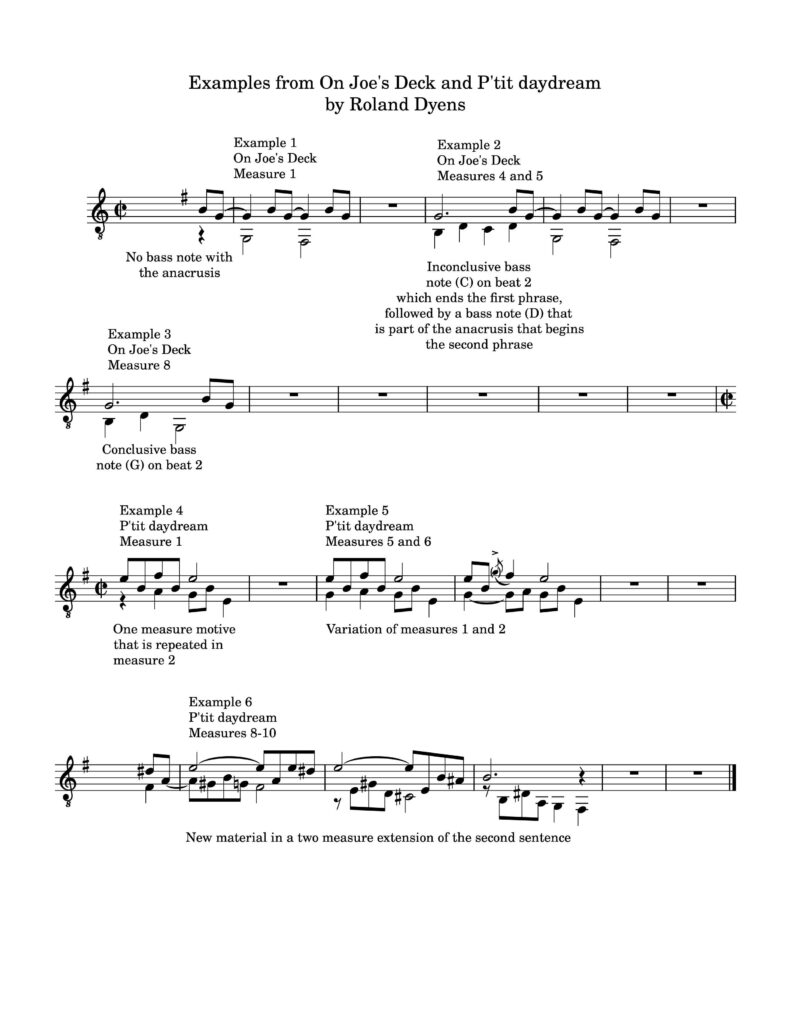Roland Dyens (1955-2016) was an imaginative and creative classical guitarist and composer who studied composition with Désiré Dondeyne at the Ecole Normale de Musique de Paris alongside his guitar studies with Alberto Ponce. Dyens’ scores contain detailed instructions regarding dynamics, rubato, and articulation, and they demonstrate refined use of numerous compositional techniques. Three of his most popular compositions are Tango en Skaï, Waltz en Skaï, and Libra Sonatine.
Les 100 de Roland Dyens is a two-volume set that contains 100 intermediate level compositions by Roland Dyens for student and amateur guitarists. Professional guitarists might also find a place for some of the 100 short compositions in their repertoire. Additionally, Les 100 de Roland Dyens is an excellent resource for aspiring composers to study Dyens’ innovative and artistic approach to composing for guitar.
This post will focus on phrase structure in the opening sections of the first two compositions in Volume 1 of Les 100 de Roland Dyens: On Joe’s Deck and P’tit daydream. In addition to being the first two pieces in the collection, both compositions are available individually.
On Joe’s Deck begins with an eight-measure period. This eight-measures period is made of two four-measure phrases: an antecedent phrase (question) and a consequent phrase (answer), much like the opening two phrases of Tarrega’s Adelita. The two phrases are identical with the exception of two bass notes. The anacrusis of the first phrase does not have a bass note (example 1), while anacrusis of the second phrase has a D in the bass (example 2). Also, the first phrase ends inconclusively on the second beat of measure 4 on the note C (example 2), while the second phrase ends conclusively in measure 8 on the bass note G (example 3). Notice that On Joe’s Deck is written with a 2/2 time signature, which is often referred to as cut time. I refer to beats one and two in each measure with reference to this time signature.
Here is a link to a performance of On Joes Deck (with an optional cello part) (https://www.youtube.com/watch?v=ndEqNjnmNfo)
P’tit daydream opens with ten measure period that is made of two sentences. A period that is made of two sentences is called a compound form. P’tit daydream begins with a four-measure sentence (measures 1-4) followed by another four-measure sentence (measures 5-8) with a two-measure extension (measures 9-10). The presentation in the first sentence (measures 1 and 2) is made of a one measure motive in measure 1 that is repeated in measure 2 (example 4). The two-measure continuation (measures 3 and 4) ends inconclusively on an inversion of a B7 chord. The second period begins with a two-measure presentation (measures 5 and 6) that is a varied repetition of the presentation of the first period (example 5). The continuation in measures 7 and 8 is a varied repeat of the continuation of the first period. However, instead of cadencing in measure 8, new material is introduced to begin a two-measure extension (measures 9 and 10), which flows seamlessly into the next phrase which begins in measure 11 (example 6). P’tit daydream is an excellent example for composition students who have mastered eight-measure period and sentence phrase structures and are ready to learn more advanced phrase structures.
The website Open Music Theory discusses combining two sentences to make a period in a section on compound forms (https://viva.pressbooks.pub/openmusictheory/chapter/phrase-archetypes-unique-forms/).
Here is a link to a performance of P’tit daydream (https://www.youtube.com/watch?v=jBvVABBuN98)

You can download a .pdf of the example page by clicking on the button below.
